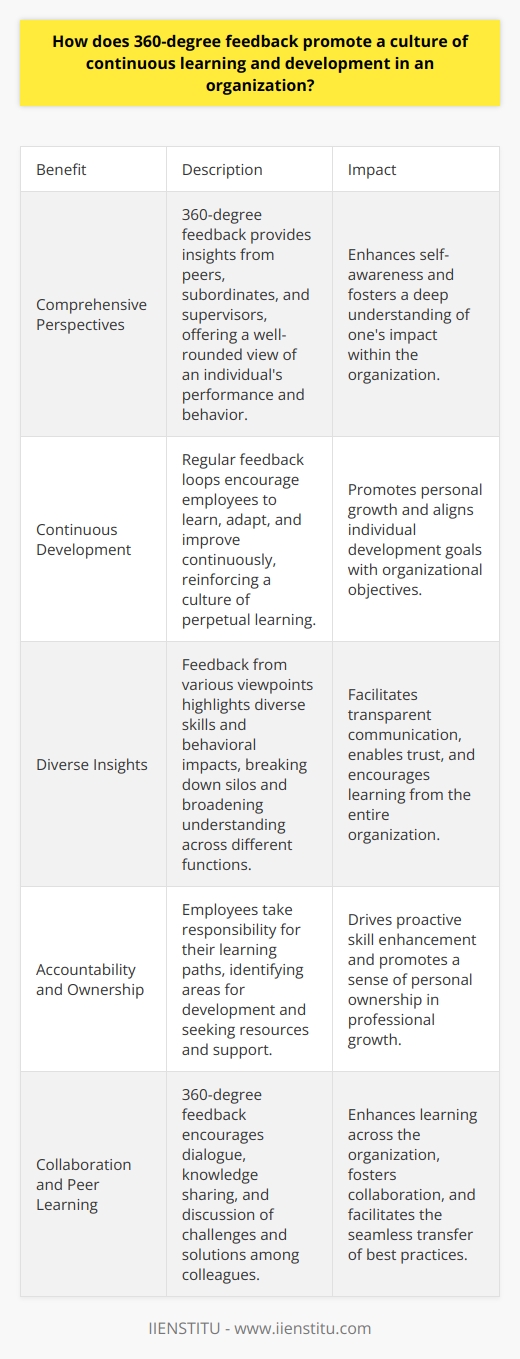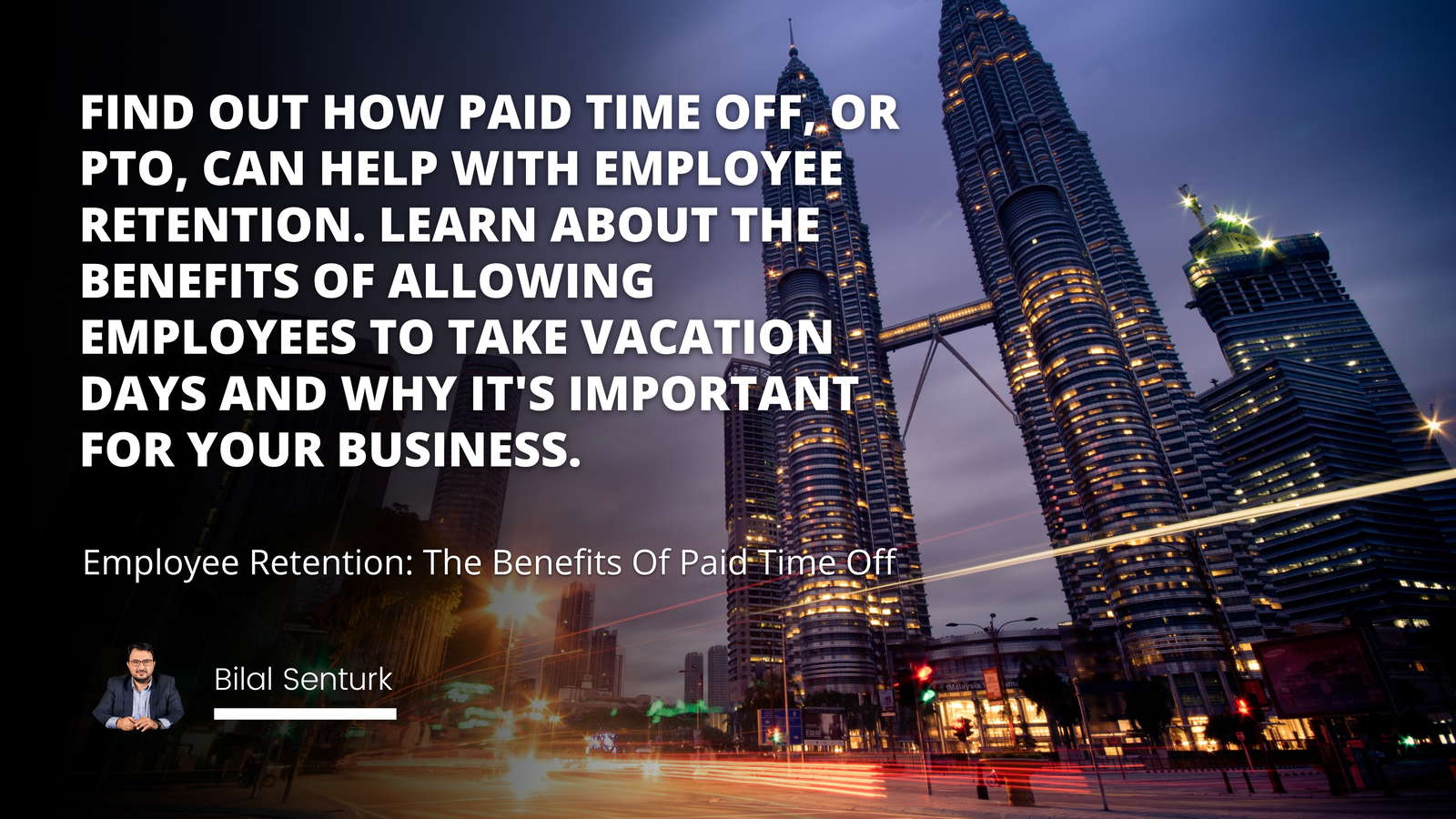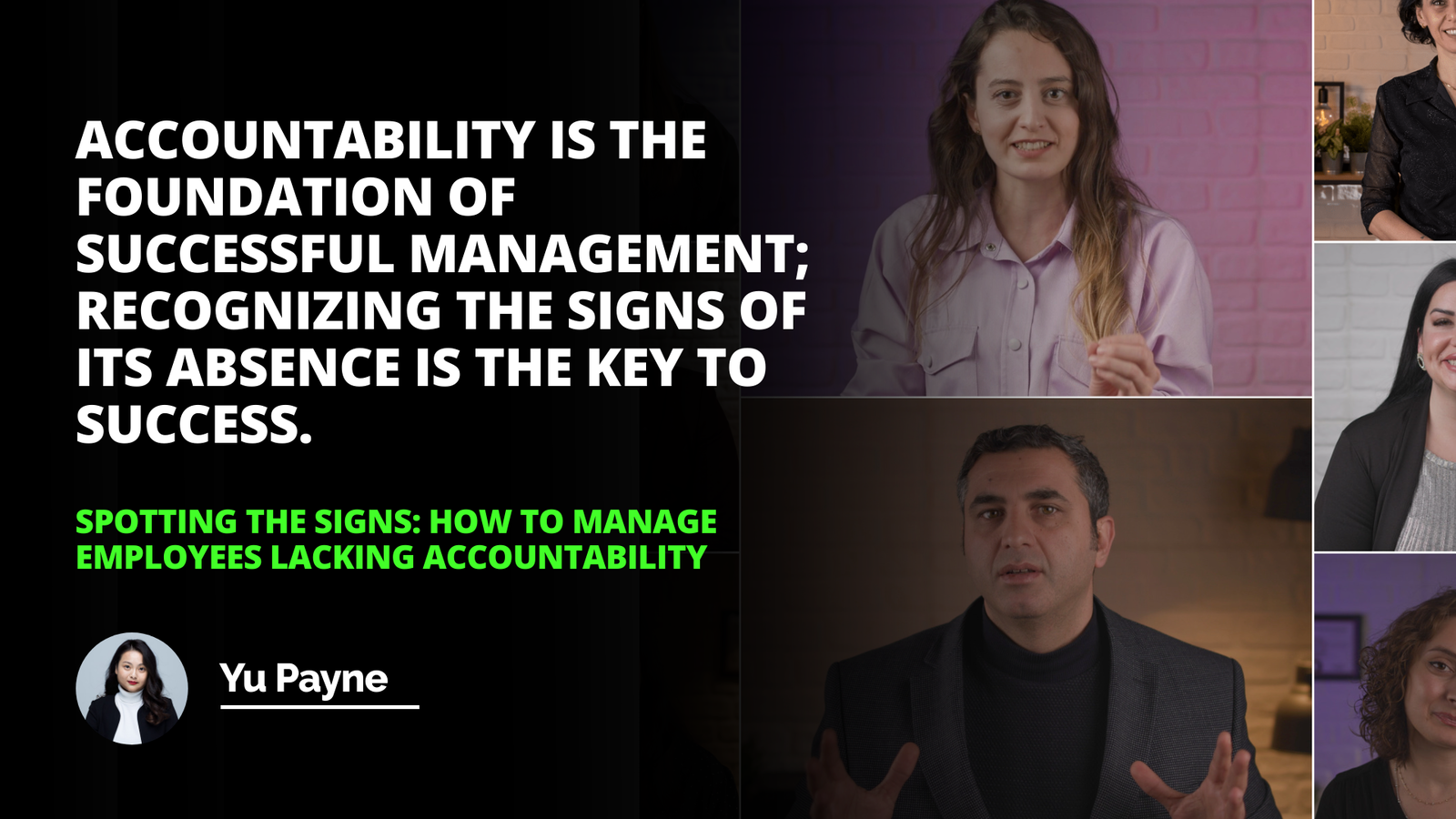
In today's competitive business landscape, organizations continually strive to unearth new strategies for enhancing productivity, strengthening leadership, and fostering a positive work environment.
One such strategic tool that has gained widespread recognition is the 360-degree feedback—a holistic approach to appraising employee performance from a myriad of perspectives. This comprehensive evaluation not only unveils hidden facets of an individual's professional demeanor but also kindles personal growth and organizational development.
In the realm of Human Resource Management, the incorporation of a 360-degree feedback system has proven to be a catalyst for transformative change.
This blog pursues an exploration into the nuances of 360-degree feedback, dissecting its benefits, challenges, and the best practices for effective implementation, thereby offering invaluable insights for those seeking to optimize human capital through cultivated feedback mechanisms.
Understanding the 360-Degree Feedback
Detailed Explanation of 360-Degree Feedback
360-degree feedback is a multi-rater evaluation tool that involves collecting performance-related feedback on an individual from various sources including, but not limited to, peers, subordinates, supervisors, and even clients.
This method offers a comprehensive view of an employee's skill set, work habits, and contribution to the workplace. Contrary to traditional performance reviews, which typically come from a single source, this multifaceted approach yields a more balanced and nuanced portrait of performance.
One factual example of 360-degree feedback application is in a multinational organization where employees span across diverse geographic locations and cultural backgrounds. By collecting feedback from a wide array of colleagues and stakeholders, the company gains insight into the employee's cross-functional and cross-cultural interactions, contributing greatly to personal and professional development plans.
The Concept of Anonymity in the 360-Degree Feedback
An integral component of 360-degree feedback is the anonymity of the raters. The assurance of confidentiality encourages honest and candid responses, minimizing the fear of retribution. This anonymity is imperative as it fosters a culture of trust and openness essential for the feedback to be constructive and valuable.
However, the challenges with anonymity cannot be discounted. It can lead to situations where the feedback might become overly critical or personal, particularly if there are unresolved conflicts. Ensuring that anonymity doesn't become a veil for inappropriate comments is crucial for the tool to function as intended.
Mechanisms for Gathering 360-Degree Feedback
In gathering 360-degree feedback, organizations typically utilize a range of mechanisms including customized online surveys, structured interviews, and informal feedback channels. Online courses often include modules that train HR professionals on crafting such surveys to maximize the efficacy of the process.
Customized online surveys are the most common method for collecting feedback. These surveys can be tailored to the competencies and skills relevant to each role, department, and level within the organization.
Structured interviews, on the other hand, allow for deeper conversations wherein raters can provide additional context to their written feedback. Informal channels, while less structured, can yield spontaneous and sometimes more honest feedback. Combining these methods serves to reinforce the validity and reliability of the feedback collected.
The Benefits of Implementing 360-Degree Feedback
Enhancement of Self-Awareness
Engaging with 360-degree feedback can significantly enhance an individual's self-awareness by highlighting strengths and identifying areas for improvement that might not have been previously recognized.
For instance, an employee may perceive themselves as an effective communicator, but feedback from peers might suggest the need for improvement in active listening skills.
In a real-world example of enhanced self-awareness through 360-degree feedback, a manager was able to adjust his leadership style effectively after receiving feedback indicating that his team found his approach to be overly authoritarian, which in turn was stifling creativity and collaboration.
Nurtures a Culture of Continuous Learning
By institutionalizing 360-degree feedback, organizations can cultivate a culture of ongoing learning and development. Employees become more receptive to learning when they understand how their work impacts others and where they stand in terms of meeting expectations.
For instance, an organization that implemented regular 360-degree feedback observed an uptick in employees proactively seeking professional development opportunities, including hr certificate courses, to address the competencies where they received constructive criticism.
Improvement of Communication and Team Dynamics
360-degree feedback can also serve as a powerful tool for improving communication and team dynamics as it encourages dialogue and fosters a shared understanding of the expectations and goals within the team.
One company reported an incident where 360-degree feedback was instrumental in resolving a long-standing issue of siloed communication.
The feedback process revealed that different departments were not effectively sharing information, leading to the implementation of cross-departmental meetings that significantly enhanced overall organizational synergy.
Challenges and Caveats to 360-Degree Feedback
Bias and Perceptual Differences
One of the most significant challenges inherent to 360-degree feedback is the potential for bias and perceptual differences among raters. These could arise from personal conflicts, favoritism, or a lack of understanding of the employee's full role and contributions.
Potential solutions or mitigation steps include training raters to recognize and overcome their biases, ensuring a diverse and representative group of raters, and using statistically validated instruments to capture feedback.
Dangers of Misinterpretation
The risk of misinterpretation of criticism as personal attacks instead of constructive feedback is another challenge that organizations face. The subtleties of language can sometimes lead to misunderstandings that have repercussions for employee morale and productivity.
To prevent such occurrences, it’s essential to provide guidelines on how to give and receive feedback effectively, and to build a supportive culture where feedback is seen as a tool for growth, rather than as a means of consequence.
Risk of Overloading with Information
Receiving a volume of feedback from multiple sources can sometimes result in an overload of information, leaving employees overwhelmed and unsure of how to prioritize action items.
Careful curation of feedback, coupled with offering a guiding framework or coaching on how to process and action the feedback, is crucial for employees to effectively navigate through the information and focus on key areas for improvement.
Best Practices in Implementing 360-Degree Feedback
Clear Objective and Communication
For a 360-degree feedback system to be successful, there has to be a clear objective and transparent communication concerning the purpose and process of the feedback from the outset. This lays a foundation of trust and helps manage expectations.
Provision of Formal Training for Ratees and Raters
Providing formal training for both ratees and raters is vital in ensuring that everyone understands the value of the process and how to engage with it effectively. This training can be facilitated through various online courses designed for professional development.
Use of Constructive and Balanced Feedback
It's equally important to emphasize the significance of providing feedback that's constructive and balanced. Feedback should include positive reinforcement as well as developmental suggestions, thereby enabling growth without creating defensiveness.
Follow-Up and Action Planning
Post-feedback, enabling a structured follow-up and action planning process is key. This helps to ensure that feedback leads to meaningful development and change within the organization, rather than being a one-off event without lasting impact.
The extensive journey through the world of 360-degree feedback reveals it as a potent instrument for driving personal growth and fortifying organizational resilience.
By illuminating the mechanisms, benefits, and challenges intrinsic to this approach, as well as outlining best practices for implementation, this analysis has sought to equip readers with the knowledge requisite for harnessing the full potential of feedback systems.
It encourages a steadfast commitment to integrating 360-degree feedback into ongoing developmental endeavors, thus leading to a transformative impact on leadership effectiveness and team dynamics. It is hoped that readers will leave this discourse not merely informed but inspired to embark on the path of feedback-informed growth.
Frequently Asked Questions
What are the key benefits and potential drawbacks of implementing a 360-degree feedback system in an organization
Benefits of a 360-Degree Feedback System
The introduction of a 360-degree feedback system can transform an organization. It brings a multi-layered approach to performance appraisals. Employees receive feedback from many sources, not just a single supervisor. These include peers, subordinates, and sometimes even customers.
Comprehensive Feedback
Multi-rater feedback offers a well-rounded view. It contrasts with traditional one-on-one appraisals. Employees gain insights from various perspectives. This helps identify strengths and hidden weaknesses.
Enhanced Self-Awareness
Feedback from several colleagues encourages personal growth. Employees understand how others perceive them. This self-awareness often leads to improved communication and teamwork.
Personal Development
When employees learn about their performance from different sources, they recognize their impact on others. This can lead to enhanced personal development. They may seek training or mentorship to build on weaknesses.
Accountability
The system holds everyone to the same standard. It offers a sense of fairness in the evaluation process. Everyone gives and receives feedback. This creates a culture of accountability.
Encouragement of a Feedback Culture
Organizations often strive for open communication. A robust 360-degree system nurtures a culture where feedback is normal. People become more receptive to constructive criticism.
Drawbacks of Implementing a 360-Degree Feedback System
Despite the potential benefits, some pitfalls exist. They should be carefully considered before implementation.
Resource Intensive
Setting up the system requires significant resources. It includes training employees and ensuring the completeness of tools.
Possibility of Discomfort and Mistrust
Feedback from several sources may overwhelm some individuals. It can lead to discomfort or mistrust. This, in turn, can create a hostile work environment.
Fear of Reprisal
Confidentiality is key. But the fear of negative consequences may persist. Participants may hesitate to provide honest feedback. Thus, the effectiveness of the process can suffer.
Misuse of Feedback
Not all employees may use feedback constructively. Some may use it to target colleagues unfairly.
Requires Effective Handling
The company must manage the system well. It should provide training and support. Without these, the feedback can become counterproductive.
To conclude, a 360-degree feedback system offers comprehensive evaluations and personal development opportunities but also has significant implementation challenges. appropriating resources, fostering trust, ensuring confidentiality, and providing support are crucial to its success.
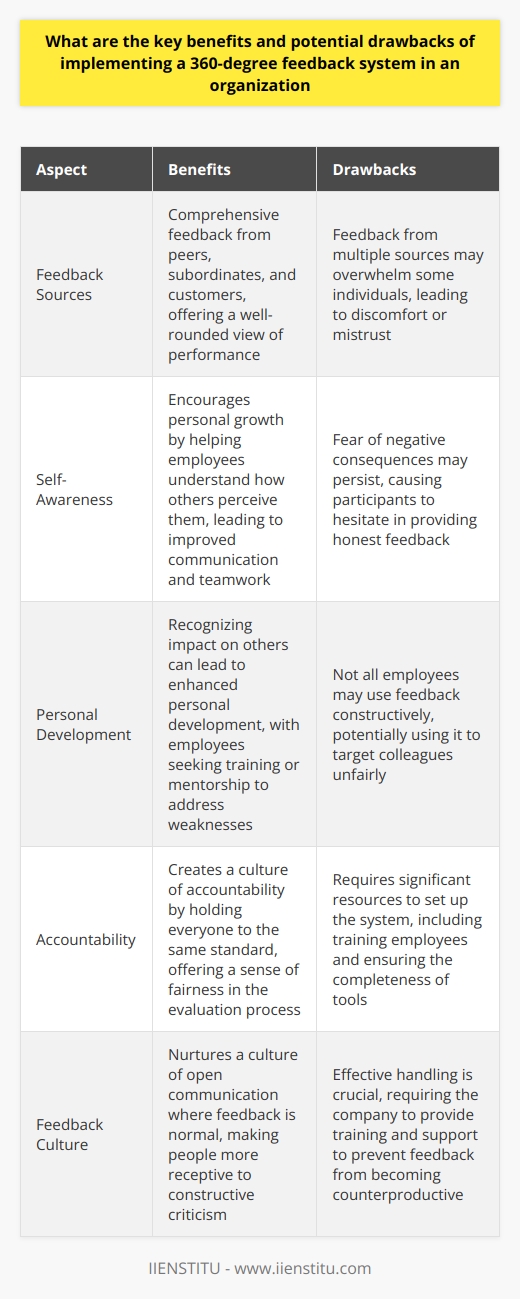
How does a 360-degree feedback system influence the overall performance and productivity of an organization
Introduction to 360-Degree Feedback
Organizations often seek effective performance review methods. They aim to enhance productivity and performance. A popular approach is the 360-degree feedback system. It offers comprehensive insights into employee performance.
Concept of 360-Degree Feedback
360-degree feedback involves multiple raters. These include peers, subordinates, and supervisors. Sometimes, customers and self-assessments are part of the process. The system gathers various perspectives on an individual's performance.
Multiple Perspectives Foster Comprehensive Evaluation
This feedback method differs from traditional top-down reviews. It provides a rounded view of employee competencies and behavior. Employees receive balanced feedback. This feedback comes from different organizational levels.
Impact on Personal and Professional Development
360-degree feedback aids personal growth. Employees understand their strengths and weaknesses better. They gain insights from various stakeholders. Self-awareness improves. With this understanding, individuals can target specific improvement areas.
Encouraging Open Dialogue and Trust Building
The system fosters communication across the organization. Openness in sharing feedback is the key. Trust among colleagues often strengthens. Employees feel valued. Their opinions matter in the process.
Enhancing Accountability and Team Dynamics
Employees become more accountable for their actions. Peers contribute to the evaluation process. Social pressure to perform well increases. As a result, a strong team dynamic can emerge. Cohesion and mutual support can improve.
Realignment towards Organizational Goals
Feedback relates to organizational values and goals. It helps align employee objectives with those of the organization. Everyone works toward shared outcomes. The organization moves forward as a cohesive unit.
Contributions to Continuous Improvement Culture
The system encourages continuous improvement. Feedback is ongoing and regular. Employees consistently reflect on their performance. They seek opportunities to enhance their skills. This ongoing development can lead to improved productivity over time.
Informing Professional Development and Training
Data from feedback informs training needs. Organizations can tailor professional development programs. This ensures relevance to current gaps. It maximizes training effectiveness and resource utilization.
Strengthening Performance Management Processes
360-degree feedback strengthens performance evaluation. It introduces multiple viewpoints into the appraisal process. This can result in fairer, well-rounded assessments. Decisions on promotions or bonuses become better informed.
Providing Basis for Reward and Recognition
Motivation often increases with recognition. The system provides a basis for recognizing achievements. Employees see their efforts acknowledged by a broad audience. Such recognition can drive future performance and productivity.
Challenging the Status Quo
This feedback approach challenges the status quo. It prompts an organizational shift. Hierarchies become less rigid. A more democratic work culture may develop. Innovation and collaboration can thrive under such conditions.
Shaping Leadership and Management Practices
Leadership styles can evolve due to 360-degree feedback. Managers gain insights into their effectiveness. They learn how their actions affect their teams. This learning can refine their management practices.
Integrating 360-Degree Feedback For Enhanced Productivity
In conclusion, 360-degree feedback is transformative. It influences overall performance and productivity positively. It drives personal growth, fosters collaboration, and cultivates a culture of continuous improvement. Organizations that integrate this feedback can reap significant benefits. They achieve a more engaged, accountable, and high-performing workforce.
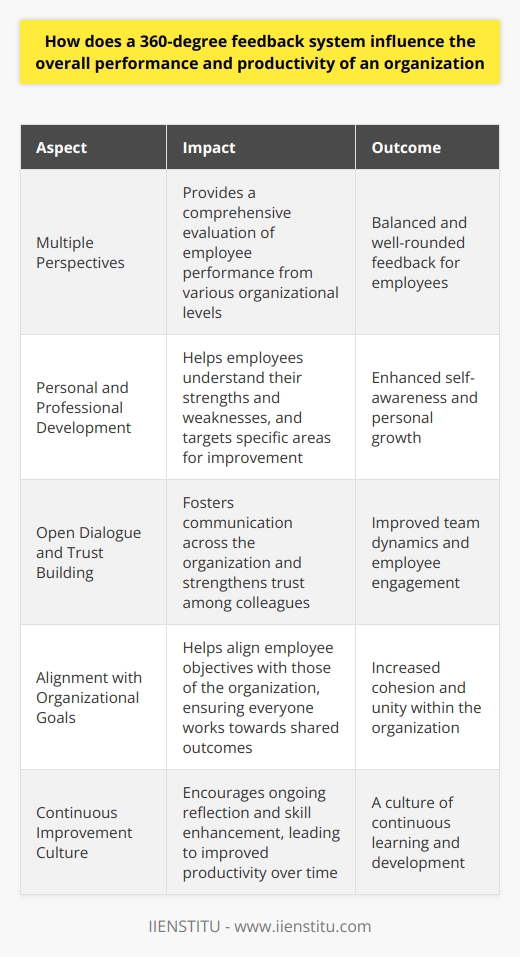
How does 360-degree feedback promote a culture of continuous learning and development in an organization?
360-Degree Feedback Fosters a Learning Environment
Organizations thrive on learning and growth. Employees shape this dynamic with their talents. Skills need nurturing to flourish. Enter 360-degree feedback, a powerful tool in this pursuit. It builds a comprehensive picture of behavior and performance. Every angle comes into view. Peers, subordinates, and supervisors all contribute.
Comprehensive Perspectives Enhance Self-awareness
Self-awareness is key to personal growth. It forms the foundation for professional development. 360-degree feedback delivers truthful, rounded insights. Individuals see themselves as others do. This mirror fosters a deep understanding of one's impact.
Encouragement for Ongoing Development
Feedback is not a one-time event. It is continuous. Regular feedback loops encourage a culture of perpetual learning. Employees learn, adapt, and improve non-stop. This process reinforces the learning culture within an organization.
Growth through Diverse Insights
Different viewpoints provide rich, diverse perspectives. They highlight varied skills and behavioral impacts. Employees benefit from feedback that is well-rounded. They align their personal development goals with these insights.
Transparent communication is paramount. It enables trust and openness. Diverse feedback breaks down silos. It broadens understanding across different functions. Individuals learn not just from their team, but from the entire organization.
Accountability Promotes Personal Ownership
With feedback comes responsibility. Employees take charge of their learning paths. They identify areas for development. They seek resources and support. Accountability becomes a driving force. It propels individuals towards proactive development.
Critical Evaluation Leads to Actionable Plans
Feedback must translate into action. Critical evaluation guides goal setting. It clarifies the pathway to skill enhancement. Employees craft actionable plans. These plans are specific, measurable, attainable, relevant, and time-bound.
Regular Feedback Reinforces Continuous Learning
Repetition is the mother of learning. Regular feedback embeds learning into routine. Employees engage in frequent reflection. They recalibrate their efforts constantly. They are agile in responding to feedback. It nurtures an adaptable and learning-centric culture.
Collaboration and Peer Learning
Feedback is not one-way. It encourages dialogue. Colleagues share best practices. They discuss challenges and solutions openly. Collaboration becomes the bedrock of collective improvement. Knowledge transfer happens seamlessly. It enhances learning across the board.
A Culture of Comfort with Change
Change is inevitable. A workforce comfortable with change excels. 360-degree feedback prepares individuals for this reality. It equips them to embrace change willingly. They evolve as the organization evolves. Adaptability becomes ingrained in organizational culture.
Self-awareness
Ongoing Development
Growth through Diversity
Personal Ownership
Actionable Plans
Reinforced Learning
Collaborative Engagement
Comfort with Change
Each component plays a role. Each shapes a culture rich in learning and development. Feedback is the thread that binds these elements. It is central to creating an environment where continuous improvement is not just encouraged, but expected.
Organizations committed to 360-degree feedback thus excel. They build a resilient and capable workforce ready for the future. They foster an environment where learning never stops. They remain competitive and agile. They retain talent that is eager to grow.
In conclusion, 360-degree feedback is not merely a tool. It is a strategic enabler of sustaining a culture of continuous learning and development within an organization. It ignites curiosity, fuels ambition, and cultivates growth-oriented mindsets. Employers and employees alike benefit from its implementation.
